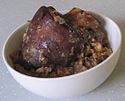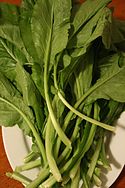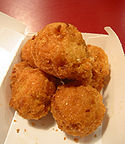List of soul foods and dishes
| Part of a series on |
| American cuisine |
|---|
 |
This is a list of soul foods and dishes.
Meat dishes
Some meat soul foods and dishes include:
| Name | Image | Description |
|---|---|---|
| Buffalo ribs | 
|
A dish consisting of the breaded and deep fried ribs of the buffalo fish . Pictured is a live buffalo fish.
|
| Fatback | 
|
Fatty, cured, salted pork, especially the first layers of the back of the pig primarily used in slow-cooking as a seasoning. Pictured is breaded and fried fatback. |
| Fried chicken | 
|
A dish consisting of breading adds a crisp coating or crust to the exterior.
Chicken and waffles, in particular, is a soul food dish associated with special occasions.[3] |
| Fried fish[1] | 
|
Any of several varieties of fish, including catfish, whiting,[4] porgies, bluegill, sometimes battered in seasoned cornmeal. Adapted from method of frying chicken. |
| Ham hocks [5][6] | 
|
Typically smoked or boiled, ham hocks generally consist of much skin, tendons and ligaments, and require long cooking through stewing, smoking or braising to be made palatable. The cut of meat can be cooked with greens and other vegetables or in flavorful sauces. |
| Hog jowl | 
|
|
| Hog maw | 
|
The stomach lining of a pig; it is very muscular and contains no fat. As a soul food dish, hog maw has often been coupled with chitterlings, which are pig intestines. In the book Plantation Row Slave Cabin Cooking: The Roots of Soul Food hog maw is used in the Hog Maw Salad recipe.[10] |
| Chitlins | 
|
Cleaned and prepared intestines of pigs, slow cooked and also often eaten with a parboiled, then battered and fried. It is adapted from early European cuisine, or hog maws[1] (the muscular lining of the pig's stomach, sliced and often cooked with chitterlings).[1]
|
| Oxtail[1] | 
|
The . |
| Pickled pigs' feet[5] | 
|
Slow cooked, sometimes pickled or often eaten with a vinegar based sauce. |
Pigs' feet
|

|
The feet of late-2000s financial crisis.[12]
|
| Pork | 
|
As a meat dish, such as ham and bacon, and for the flavoring of vegetables and legumes, gravies and sauces. |
| Pork ribs | 
|
The Native American influence.
|
| Poultry | 
|
Pictured is a chicken gizzard dish. |
Shit on a Shingle
|
 |
Chipped beef with a bechamel sauce, served on toast. Additional toppings, gravy, or beef stock may also be added. |
| Turkey | 
|
Neck bones |
Vegetables and legumes
Beans, greens and other vegetables are often cooked with ham or pork parts to add flavor.
| Name | Image | Description |
|---|---|---|
| Black-eyed peas [5] | 
|
Often mixed into Hoppin' John or as a side dish.[1] Pictured are black-eyed peas with smoked hocks and corn bread. |
Collard greens
|

|
A onions and seasonings.
|
| Hoppin' John[14] | 
|
A dish traditional to the Low country region of South Carolina consisting of field peas) and rice, with chopped onion and sliced bacon, seasoned with a bit of salt.[15] Some people substitute ham hock, fatback, or country sausage for the conventional bacon; a few use green peppers or vinegar and spices . This dish originated in the South Carolina Low Country but is now popular in many areas of the south.
|
Mustard greens
|

|
A species of mustard plant. Subvarieties include southern giant curled mustard, which resembles a headless cabbage such as kale, but with a distinct horseradish-mustard flavor. It is also known as green mustard cabbage. |
| Okra[16] | 
|
A vegetable that is native to West Africa, and is eaten fried or stewed and is a traditional ingredient of gumbo. It is sometimes cooked with tomatoes, corn, onions and hot peppers |
| Fried okra | 
|
Okra pods that have been sliced and dredged in cornmeal before frying. |
| Sweet potatoes | 
|
Often candied yams"[5]
|
Turnip greens
|

|
Turnip leaves are sometimes eaten as "turnip greens", and they resemble mustard greens in flavor. Turnip greens are a common side dish in southeastern US cooking, primarily during late fall and winter. Smaller leaves are preferred; however, any bitter taste of larger leaves can be reduced by pouring off the water from initial boiling and replacing it with fresh water. Varieties specifically grown for the leaves resemble mustard greens more than those grown for the roots, with small or no storage roots. |
Breads and grains
| Name | Image | Description |
|---|---|---|
| Cornbread[17] | 
|
A fat; inspired by the great availability of corn in America. Cornbread is of Native American origin. Traditional southern cornbread is baked in European cake and bread baking style. Pictured is skillet cornbread. |
| Grits[18] | 
|
A cooked coarsely ground cornmeal of Native American origin. |
| Hoecake[1] | 
|
Also known as Johnnycake, a type of cornbread that is thin in texture, and fried in cooking oil in a skillet, whose name is derived from field hands' often cooking it on a shovel or hoe held to an open flame. |
| Hushpuppies[1] | 
|
Balls of deep-fried cornmeal, usually with salt and diced onions. Typical hushpuppy ingredients include cornmeal, wheat flour, eggs, salt, baking soda, milk or buttermilk, and water, and may include onion, spring onion (scallion), garlic, whole kernel corn, and peppers. |
Desserts
| Name | Image | Description |
|---|---|---|
| Sweet potato pie[1][4] | 
|
pureed, spiced, and baked in a pie crust, similar in texture to pumpkin pie
|
| Banana pudding[19] | 
|
Pudding made with vanilla custard, vanilla wafers, bananas, whipped cream and vanilla extract |
| Red velvet cake[20] | 
|
Red colored cake made with cocoa powder
|
| Pecan pie[21] | 
|
Pie made with pecans
|
Regional Soul Food
These are more specific regional Soul food dishes.This includes dishes like Jambalaya, Gumbo, red rice and beans and other foods of the creole subgroup of the Black American ethnic group. It also includes the dishes of the Gullah Geeche sub group of the Black American peoples. See: Louisiana Creole cuisine and Gullah Geeche Cuisine
See also
- List of American foods
- List of foods of the Southern United States
- Louisiana Creole cuisine
- List of American desserts
References

- ^ ISBN 978-0231146388. Retrieved June 29, 2009.
- ^ Ferguson 1993
- ^ "Serving up chicken & waffles". Los Angeles Business Journal. September 22, 1997. p. 1.
- ^ a b Feeney, Kelly (May 8, 2009). "Soul Food With a Secret". The New York Times. Retrieved March 27, 2013.
- ^ a b c d e Timothy Williams In Changing Harlem, Soul Food Struggles 5, 2008 New York Times
- ^ a b Mike Royko FOOD NAGS CAN KILL ANYONE'S APPETITE July 20, 1994 Page: 3 Chicago Tribune
- ISBN 9781438108575. Retrieved 28 July 2012.
- ^ Fabricant, Florence (September 13, 2011). "Pork Jowl With a Backwoods Whiff". New York Times. Retrieved July 27, 2012.
- ISBN 9780312302801. Retrieved 28 July 2012.
- ^ "Plantation Row Slave Cabin Cooking: The Roots of Soul Food". Retrieved 2007-10-08.
- ^ Blumenthal, Heston (14 November 2003). "The twist in the tail". The Guardian. London. Retrieved 16 August 2012.
- ^ Carmichael, Sri (21 October 2009). "Pig's trotters fly off the shelves as customers seek cheap meat cuts". The Evening Standard. Archived from the original on 24 October 2009. Retrieved 28 March 2013.
- ^ Diana Rattray, About.com Guide (2012-04-10). "Mixed Greens - Recipe for Greens". Southernfood.about.com. Retrieved 2012-07-26.
- ^ "On New Year's Day, it gets the full Southern treatment, which usually means Hoppin' John – a traditional Soul Food fixin' consisting of F peas cooked with ham hocks and spices, served over rice. In the South, eating field-peas on New Year's is thought to bring prosperity" Celebrate New Year's with Field- peas by Rachel Ellner December 31, 2008 Nashua Telegraph
- ^ Hoppin John What's cooking America.Another name for it is Stew Peas
- ISBN 0123918839
- ^ St. John, Warren (October 6, 2004). "Greens in Black and White". The New York Times. Retrieved March 28, 2013.
- ^ Ferguson 1993, pp. 25-26.
- ^ 7 Soul Food Dessert Recipes You Have To Try
- ^ Dessert
- ^ "Soul Food Dessert Recipes - Taste Like Grandma's".
Bibliography
- Ferguson, Sheila (1993). Soul Food: Classic Cuisine from the Deep South. Grove Press. ISBN 0802132839
Further reading
- Woods, Sylvia (1992). Sylvia's Soul Food. HarperCollins. ISBN 0688100120
